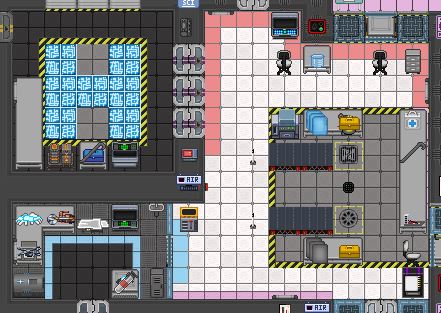Robotics: Difference between revisions
(→Borgs) |
(→Mechs) |
||
| Line 25: | Line 25: | ||
== Mechs == | == Mechs == | ||
Mechs are powerful devices that, unlike other robots, require a pilot to function. They generally have increased carrying capacity and strength. This also lets them pack a punch in combat. However, mechs require a massive quantity of resources and time to build, making them a long-term goal rather than a quick solution to a threat | [[ Mechs ]] are powerful devices that, unlike other robots, require a pilot to function. They generally have increased carrying capacity and strength. This also lets them pack a punch in combat. However, mechs require a massive quantity of resources and time to build, making them a long-term goal rather than a quick solution to a threat. | ||
== Bots == | == Bots == | ||
Revision as of 01:13, 14 December 2023
 
|
This page is unfinished!
This page has been recently created or hasn't been been completed yet. |
The robotics system of SS14 has not been extensively developed upon as of writing this.
Robotics
Currently one of the least fleshed out systems, alongside genetics and virology. While fairly limited in practical use, robotics knowledge can still be useful in some scenarios. Key research milestones include Robotics technology, Salvage technology and Ripley technology.
To restate, there is not a lot of content here. Please don't be disappointed.
Exosuit Fabricator
The womb from which all robots emerge, bit by bit. Every robotics lab is outfitted with one by default, so no worries trying to make one.
| Image | Name | Description |
|---|---|---|
| Borg Parts | Pretty basic stuff. Miscellaneous appendages and chassis parts for smaller robots. | |
| Mech Parts | Used to create a mech. |
Mechs
Mechs are powerful devices that, unlike other robots, require a pilot to function. They generally have increased carrying capacity and strength. This also lets them pack a punch in combat. However, mechs require a massive quantity of resources and time to build, making them a long-term goal rather than a quick solution to a threat.
Bots
Lil' automatons who can help in equally small ways.
Cyborgs
Cyborgs are robots that are controlled by players. They are subject to all laws regarding silicons, no matter what role they held before becoming a cyborg. Cyborgs can be created in two ways:
- First, a scientist can take the brain of a dead player and insert it into a Man-Machine Interface, which can be crafted at the Exosuit Fabricator. This will allow the dead crewmate to speak with other crewmates again, but will not allow for movement or interaction with objects. Once the brain has been inserted into a Man-Machine Interface, the scientist can place the interface into a cyborg, allowing the player to control the cyborg.
- The other method involves the use of a Positronic Brain. A positronic brain is a cube-like object that is crafted using the Exosuit Fabricator. Once crafted, the cube can be possessed by a dead player, transforming them from a ghost to an AI. The AI in this state is similar to a Man-Machine Interface in that it can communicate with crewmates but can't move or interact with objects. The Positronic Brain can then be inserted into a cyborg, giving the AI control of the cyborg.






